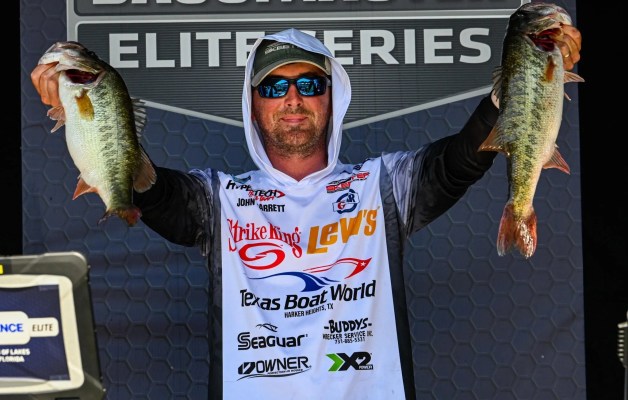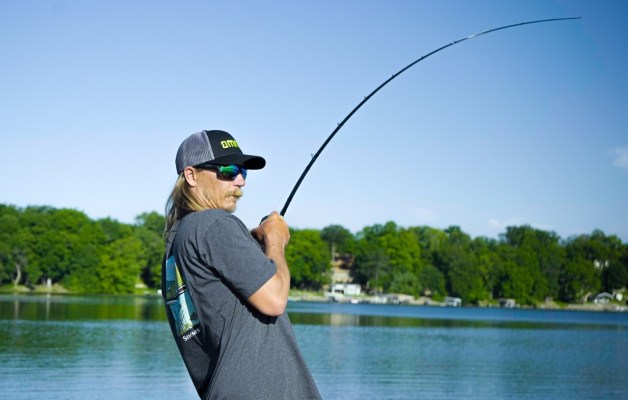It's been a couple of months since Bassmaster Elite Series pro Paul Elias won the FLW tournament on Lake Guntersville with the "new" Alabama Rig, and since that time much of the furor surrounding the device has died down, but I'm still shocked at just how divisive the rig continues to be.
If anecdotal evidence is reliable here, it seems that the bass fishing public lines up something like this:
– 60 percent think castable umbrella rigs (CURs) are OK — just another tool in an angler's arsenal to be pulled out when conditions warrant. Let's call them the "If it works, I want it" group.
– 25 percent are scrambling to buy, borrow or steal one. Marketers call these people the "Early Adapters," so we will, too, just to be cool.
– 10 percent (let's call them the "Chicken Littles ") think CURs are the spawn of Satan and should be banned from United States waters, the Northern Hemisphere and perhaps even the Milky Way Galaxy.
– 5 percent are currently manufacturing these devices and have received threatening calls, emails or letters from The Alabama Rig people. We'll call them the "Claim Jumpers," because all the Alabama rig folks have right now is a claim, not an actual patent they can enforce.
Count me in the first group. Because I work in the industry, I was able to get a few CURs after the craze hit. Otherwise, I might have found myself among the Early Adapters.
As for the 5 percent trying to grab a share of the market, I wish good luck to those who are not in violation of the Alabama Rig's pending patent and who are actually making improvements to the concept.
Rest assured that whatever the original does, there will be modifications, alterations and yes, even improvements in the very near future, and these tweaks will come from all corners of the bass fishing world as anglers adapt the rig to their waters and fishing styles.
What I don't get are the 10 percent who want to see the things eradicated from the sport. Really, what are they thinking?
To read their comments online or check out their petitions, you'd think CURs are akin to dynamite or electrofishing — just toss 'em in the water and get the net ready. Better yet, get three or four or five nets ready, because they seem to think the A-rig is going to catch that many bass on each and every cast.
That, of course, is ridiculous, and they should know better.
The CUR is only a tool — like any other rig or lure — that has its time and place. And it's so new to the bass fishing market that we really don't know just yet what that place or time might be. If you believe the folks who are manufacturing these rigs, that time and place is anytime and anywhere. But plenty of anglers have tried a CUR and not caught a limit with each cast … or even a single bass after hauling water for hours.
So far it looks as though the CUR is quite the ticket on suspended bass. That's a big deal because suspended bass are often in a non-feeding mode and almost always difficult to catch. The sight of a small school of baitfish swimming by is apparently enough to trigger some of these fish into feeding — at least some of the time.
Folks who have tried them tell me you can use a CUR to fish soft plastics or spinnerbaits or just about anything else and that they work from the surface on down. I expect that's true, but I doubt it's as effective as other presentations most of the time.
Don't get me wrong. I'll be experimenting with CURs and hope to catch my fair share of bass with them. I just don't expect them to be the answer to most of my fishless casts. After all, no other approach or technique works all the time; what angler in his right mind would think this is the be-all-end-all answer?
As for those who think CURs should be outlawed because they'll destroy our fisheries, history is against you.
About 60 years ago some anglers were up in arms when Creme introduced the first soft plastic worm. They thought it too deadly, too effective and too easy to use. Surely bass populations would be eradicated wherever these tempting morsels were offered.
When sonar became affordable in the 1950s and '60s, another group (no doubt with significant overlap from the first) protested the Lowrance Green Box, saying that "underwater eyes" gave anglers an unfair advantage. Surely bass would go the way of the dodo if this horrible technology became standard equipment on fishing boats.
Underwater cameras met with the same disdain in the 1990s. Detractors said that if you could lower a camera into the water and watch the fish and your lure interact, that would surely be the end of fishing as we know it.
A decade or so ago, when global positioning systems were becoming commonplace on bass boats, they, too, had their Chicken Littles — fishermen who said the devices tipped the scales too far in favor of anglers — who wanted GPS barred from tournaments and banned from their waters.
Of course, none of these devices were the doomsday machines their detractors claimed they were, and none had anything like a devastating effect on bass fisheries. They all had their day in the sun and several have proven themselves worthy as regular items in a bass angler's arsenal, but nothing more than that.
If none of those examples are quite specific enough for you, let's look at the thing itself. The Alabama Rig is nothing more than a variation on the umbrella rig that's been around for at least 30 years. Do a little checking. You'll find that the umbrella rig hasn't destroyed a single striper fishery in all that time. Surely we're smart enough to learn something from that.
If you're concerned that CURs are going to upset the balance of the fishing economy because anglers are going to spend their money on these harnesses rather than on baits, think again. The CUR doesn't work unless you put several baits on it. It just might be the shot in the arm that the industry needs right now, though I doubt it will have a long term impact. By the time ICAST rolls around in the summer, the Alabama Rig won't be the buzz. All the attention will be on variations and spin-offs of the original.
If you're a tournament angler who thinks CURs are somehow going to upset the competitive balance on the water, man-up and learn to use the thing. When a new technique or technology comes along, the best anglers always find a way to adapt and grow. Anyone who doesn't is rightfully left behind.
If you don't like CURs because they're "designed" to catch more than one fish at a time, so what? A double fluke (donkey) rig and the old Norman Front Runner fished in tandem with a topwater bait are designed to catch more than one bass at a time, too. If you've ever hooked a bass on a multiple hook lure and fought it a little longer than necessary in hopes that a second (or third) bass would grab the other hook, you were intentionally doing the same thing. As long as we have creel limits and people exercise reasonable fish care, what does it matter? Besides, the talk of multiple hook-ups on CURs is overplayed. When fish are caught on the things, it's usually just one.
And if you're still among the 10 percent who want to eradicate the castable umbrella rig, I have only this bit of unsolicited advice:
Relax. The sky is not falling.





